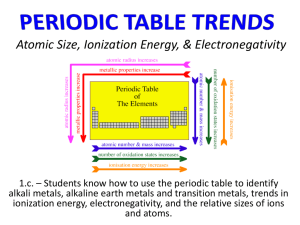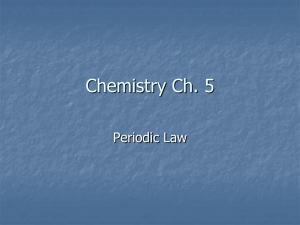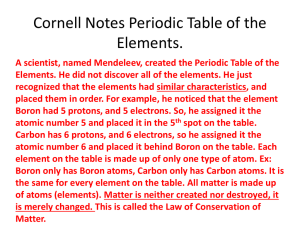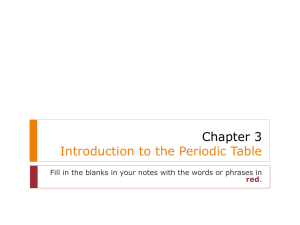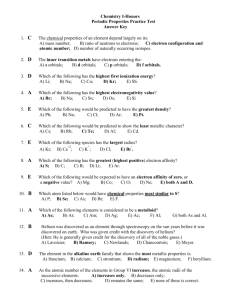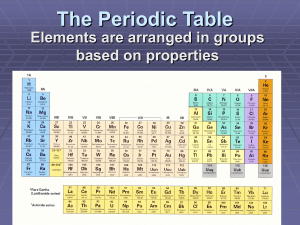Chapter 6 Notes - Hingham Schools
advertisement
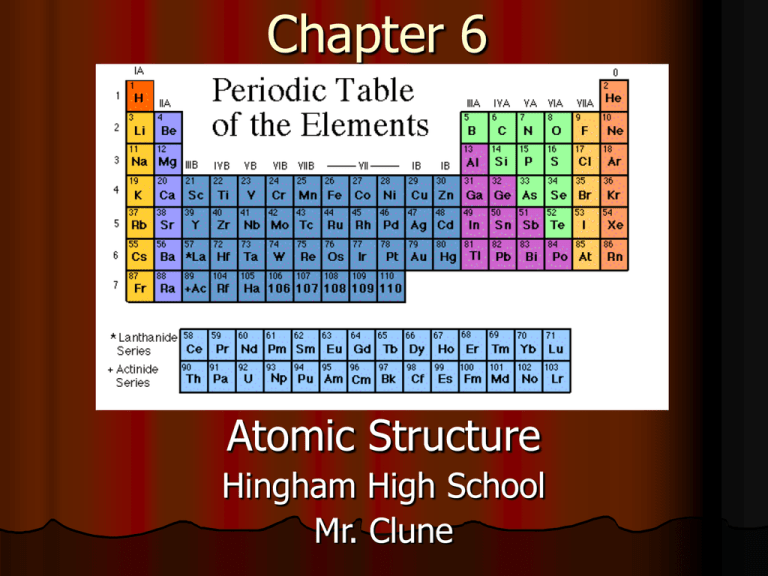
Chapter 6 Atomic Structure Hingham High School Mr. Clune Development of the Periodic Table mid-1800s, about 70 elements Dmitri Mendeleev – Russian chemist Arranged elements in order of increasing atomic mass Thus, the first “Periodic Table” Dimitri Mendeleev Mendeleev Periodic Table Mendeleev Left blanks for undiscovered elements When discovered, good prediction Problems Co or inconsistencies? and Ni; Ar and K; Te and I New way Henry Moseley – British physicist Arranged elements according to increasing atomic number The arrangement today Symbol, atomic number & mass Henry Moseley Periodic table Horizontal rows = Period There are 7 periods Periodic law: Vertical column = Group (or family) Similar physical & chemical prop. Identified by number & letter Horizontal rows are called periods There are 7 periods Vertical columns called groups Elements are placed in columns by similar properties Also called families Periodic Law When elements are arranged in order of increasing atomic number, there is a periodic repetition of their physical and chemical properties. Groups of Elements The vertical columns in the Periodic Table. Elements in each group have similar properties. Groups of Elements Example: Group 11 Copper Silver Gold Metals - Metalloids – NonMetals Metals •80% of the elements •Good Conductor •Heat •Electricity •High luster or sheen •Reflect light Metals •Ductile (Pulled into wire) •Malleable (Hammered into sheets) Non-Metals •Non-Metals are not Metals (Properties unlike Metals) •Bad Conductors (Except Carbon) •Brittle (Shatter) Non-Metals •Most are Gases Oxygen, Nitrogen, Hydrogen!! •Some are Solid (Sulfur and Phosphorus) •Some are liquid Bromine is a dark brown liquid. Areas of the periodic table Group A elements = representative elements Wide range of phys & chem prop. Metals: electrical conductors, have luster, ductile, malleable Metalloids •Staircase separating Metals and Nonmetals •Properties similar to Metals and Nonmetals •Sometimes acts like a metal. •Sometimes acts like a nonmetal. Silicon •Pure Silicon - Nonmetal. •Bad Conductor !!! •Add Boron •Conducts electricity •SemiConductor Squares in a Periodic Table •Atomic Number •Electron Configuration •Chemical Symbol •Name •Mass Number 14 Si Silicon 28.086 2 8 6 Noble Gases Alkaline Earth Metals Alkali Metals Metalloids NonMetals Transition Metals Elements Halogens Electron Configuration in Groups H Li 1 3 Na 11 K 19 Rb 37 Cs 55 Fr 87 1s1 1s22s1 1s22s22p63s1 Group 1 – 1 _s 1s22s22p63s23p64s1 1s22s22p63s23p64s23d104p65s1 1s22s22p63s23p64s23d104p65s24d10 5p66s1 1s22s22p63s23p64s23d104p65s24d105p66 s24f145d106p67s1 Group 18 – 16 _p 1s2 He 2 Ne 2 2 6 1s 2s 2p 10 1s22s22p63s23p6 Ar18 1s22s22p63s23p64s23d104p6 Kr 36 1s22s22p63s23p64s23d104p65s24d105p6 Xe 54 1s22s22p63s23p64s23d104p65s24d10 Rn 5p66s24f145d106p6 86 s1 S- block s2 Alkali metals all end in s1 Alkaline earth metals all end in s2 really should include He, but it fits better later. He has the properties of the noble gases. Transition Metals -d block s1 d1 d2 d3 d5 s1 d5 d6 d7 d8 d9 10 d The P-block p1 p2 p3 p4 p5 p6 B C N O F Ne F - block inner transition elements f1 f2 f3 f4 f5 f6 f7 f8 f9 f10 f11 f12 f13 f14 1 2 3 4 5 6 7 Each row (or period) is the energy level for s and p orbitals. 1 Transition Elements 2 3 4 5 6 7 Inner Transition Elements Atomic Radius = half the distance between two nuclei of a diatomic molecule. Atomic Size } Radius Trends in Atomic Size Influenced by three factors: 1. Energy Level Higher energy level is further away. 2. Charge on nucleus More 3. charge pulls electrons in closer. Shielding effect (blocking effect?) Group Trends As we go down a group... each atom has another energy level, so the atoms get bigger. H Li Na K Rb Periodic Trends As you go across a period, the radius gets smaller. Electrons are in same energy level. More nuclear charge. Outermost electrons are closer. Na Mg Al Si P S Cl Ar Trends in Atomic Size Size generally increases Trends in Ionization Energy The amount of energy required to completely remove an electron from a gaseous atom. Removing one electron makes a 1+ ion. The energy required to remove the first electron is called the first ionization energy. Ionization Ion – A charged atom. Gains or loses electrons Cation – Ion with a positive charge Loses electron(s) Anion – Ion with a negative charge Gains electrons + Na e- Cl Ionization Energy The second ionization energy is the energy required to remove the second electron. Always greater than first IE. The third IE is the energy required to remove a third electron. Greater than 1st or 2nd IE. Symbol H He Li Be B C N O F Ne First Second Third 1312 2731 520 900 800 1086 1402 1314 1681 2080 11810 14840 3569 4619 4577 5301 6045 6276 5247 7297 1757 2430 2352 2857 3391 3375 3963 What determines IE The greater the nuclear charge, the greater IE. Greater distance from nucleus decreases IE Filled and half-filled orbitals have lower energy, so achieving them is easier, lower IE. Group trends As you go down a group, first IE decreases because... The electron is further away. Periodic trends All the atoms in the same period have the same energy level. But, So increasing nuclear charge IE generally increases from left to right. Trends in Ionization Energy Energy generally increases Trends in Ionic Size Cations form by losing electrons. Cations are smaller that the atom they come from. Metals form cations. Cations of representative elements have noble gas configuration. Ionic size Anions form by gaining electrons. Anions are bigger that the atom they come from. Nonmetals form anions. Anions of representative elements have noble gas configuration. Group trends Adding level Ions energy get bigger as you go down. Li1+ Na1+ K1+ Rb1+ Cs1+ Periodic Trends Across the period, nuclear charge increases so they get smaller. Energy level changes between anions and cations. Li1+ B3+ Be2+ C4+ N3- O2- F1- Anions decreases Size increases Trends in Ionic Size Size of Cations increases Electronegativity The tendency for an atom to attract electrons to itself when it is chemically combined with another element. How fair is the sharing? Big electronegativity means it pulls the electron toward it. Atoms with large negative electron affinity have larger electronegativity. Group Trend The further down a group, the farther the electron is away, and the more electrons an atom has. More willing to share. Low electronegativity. Periodic Trend Metals are at the left of the table. They let their electrons go easily Low electronegativity At the right end are the nonmetals. They want more electrons. Try to take them away from others Trends in Periodic Table Atomic Size Decreases Ionization Energy Increases Electronegativity Increases Nuclear Charge Increases Shielding is Constant Shielding Increases Nuclear Charge Increases Electronegativity Decreases Ionization Energy Decreases Ionic Size Increases Atomic Size Increases Cation Size Decreases Anion Size Decreases Homework Worksheets 6-2, 6-3 Due: 11/22/04 Test: 11/23/04



